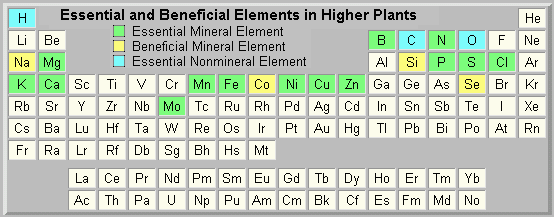
The essential mineral elements are:
Nitrogen, phosphorus, potassium, calcium, magnesium, sulfur, boron, chlorine, iron, manganese, zinc, copper, molybdenum, and nickel.
In addition to the essential mineral elements are the beneficial elements, elements which promote plant growth in many plant species but are not absolutely necessary for completion of the plant life cycle, or fail to meet Arnon and Stout's criteria on other grounds. Recognized beneficial elements are:
Silicon, sodium, cobalt, and selenium
Other elements that have been proposed as candidates for essential or beneficial elements include chromium, vanadium, and titanium, although strong evidence is lacking at this time.
Another group is the essential nonmineral elements, elements taken up as gas or water, which are:
Hydrogen, oxygen, and carbon
Out of all of the many natural elements, essential mineral elements, essential nonmineral elements, and beneficial elements are not randomly scattered, but instead cluster in several groups on the periodic chart.

Various classification schemes for essential elements include:
This page was modified by Phillip Barak, Univ. of Wisconsin, on 10 Jan 1997 and 11 Feb 2003. All rights reserved. Client-side image map added 25 Jan 1998. Alt tags to image map added 18 Mar 1998